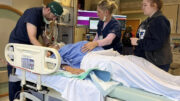PITTSBURGH (AP) – About 100 yards from the finish line of last year’s Pittsburgh Marathon, where a body pushed to its physical limit prepares for its endorphin-filled reward, a runner collapsed, the victim of a cardiac event.
Doctors immediately converged on the runner, performed CPR and shocked the man with a defibrillator. He was rushed to a hospital, where he woke up three days later.
The reason he lived was clear.
“It was because he had immediate medical attention,” said marathon director and CEO Patrice Matamoros. “We were able to help bring him back.”
What could have devolved into a nightmare turned out to be a revelatory moment for marathon officials. What if the man had collapsed at a point on the course where medical assistance wasn’t nearly as close? And what could they do to try to ensure that all runners could get the same kind of treatment regardless of where on the course they might experience problems?
Now they have an answer: This year, for the first time, medical professionals will be embedded as runners in the race, participating in both the half and full marathons, and keeping an eye on and tending to runners who are in need of immediate assistance or are visibly struggling.
“We know time is of the essence,” said Aaron Mares, the marathon’s assistant medical director. “If there is an unfortunate event, the sooner you can get to someone to help care for them or resuscitate them, the better chance they have. The impact, potentially, could be huge.”
As daunting as the task of providing medical assistance for more than 35,000 runners may seem, the marathon’s step in providing care is one its organizers believe can make a profound difference.
Ten doctors, many of whom specialize in emergency medicine, will be spaced out across the course, some running the full marathon and some the half, with each moving at a different pace. They will be equipped with belts in which they will carry a cell phone to call for further assistance if they encounter an emergency and a red marker to mark the race bib of a runner who has been treated. Matamoros said that outside of a race in Washington, D.C., which a co-worker mentioned to her, she knows of no others that have doctors running on the course who are officially designated as potential first responders.
The added measure is meant to be as preventive as it is reactionary. If one of the doctors sees a racer in pain or discomfort, even if the person is still running, the doctor will stop that person, ask questions and evaluate whether the runner should continue.
“Some people struggle because they’re so dedicated and they spent so much time training that they may try to run through an injury,” said Frank Guyette, one of the doctors who will be in the half marathon. “They may not be in the best state of mind to make that decision.”
In addition to the doctors in the race, the marathon has 17 medical stations along the course, with one every two or three miles in the first 20 miles and about one every mile in the final six miles, as well as stations at the start and finish lines. The marathon also utilizes 29 ambulances and medical professionals on bicycles and motorcycles.
Still, there was a need for more. As Dr. Mares put it, “You can’t stick an ambulance every 100 yards for 26.2 miles.”
The 10 doctors participating this year are active runners who were planning on taking part in the race before this opportunity arose. Dr. Guyette, for example, has run in the full or half marathon every year since the event came back in 2009.
“People just came out of the woodwork to volunteer,” Dr. Mares said.
Last year, of the 30,000 race participants, 376 people were treated by the medical team, 49 of whom were transported to hospitals, including two spectators who went into labor. There also have been deaths – one in 2013 and two in 1990.
Most cases the doctors encounter likely won’t be as severe as the one near the finish line last year; the most common injuries during distance races are strains, sprains, muscle cramps and, depending on the temperature during the race, dehydration.
Any way the doctors will be able to help will be viewed as a benefit for a race that strives to protect its participants.
“The way we see it is, we’ll go through every length we possible can proactively to save a life,” Matamoros said. “It’s us caring about our runners out there and making sure we have as many different things and people who can help them along the way.”






































